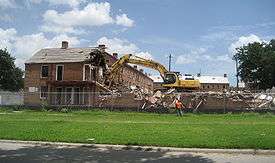Lafitte Projects
| Faubourg Lafitte Housing Development | |
| Lafitte Projects | |
| New Orleans Neighborhood | |
| Country | United States |
|---|---|
| State | Louisiana |
| City | New Orleans |
| Planning District | District 1, Treme |
| Elevation | 0 ft (0.0 m) |
| Coordinates | 29°56′19″N 90°05′38″W / 29.93861°N 90.09389°WCoordinates: 29°56′19″N 90°05′38″W / 29.93861°N 90.09389°W |
| Area | 0.30 sq mi (0.8 km2) |
| - land | 0.30 sq mi (1 km2) |
| - water | 0.00 sq mi (0 km2), 0% |
| Population | 379 (2010) |
| Density | 1,263/sq mi (488/km2) |
| Timezone | CST (UTC-6) |
| - summer (DST) | CDT (UTC-5) |
| Area code | 504 |

The Lafitte Projects were one of the Housing Projects of New Orleans and were located in the 6th Ward of New Orleans Treme neighborhood. It was one of Downtown New Orleans' oldest housing developments and had many associated problems before being severely flooded and damaged during Hurricane Katrina in 2005. By a Department of Housing and Urban Development (HUD) decree, the projects were demolished and redeveloped as affordable, mixed-income housing. The redevelopment effort was charged with replacing every demolished unit. The large housing project was left mostly vacant following evacuations after the extensive flooding from Hurricane Katrina. Heated arguments have surrounded the demolition of the project, as some longtime residents wanted them renovated.[1]
History
Lafitte was constructed in 1940 and opened in August of 1941 with 896 units housing 3,000 tenants. It was one of the first housing projects for African Americans in Louisiana. During its early years, it was labeled as the largest and finest U.S. Housing Authority low-rent project in the South. Lafitte was the fifth of six local housing projects to be built in New Orleans. [2] In the 1980s, the project began to rapidly decline as crack-cocaine flooded Treme. Living conditions also became a problem as well as crime. Drug dealing and shootings became common in the development and eventually caused problems for New Orleans Police Department 1st District officers who patrolled the area at night. It became one of five New Orleans Housing projects riddled with violence and murder.[3] The Lafitte development was originally set for demolition in 1995 but was postponed and later canceled. After Hurricane Katrina, the project was in stable condition but remained closed and later demolished in 2008.
The first phase of the development plan included 134 on-site affordable rental units completed in December 2010 and 47 on-site affordable homeownership units to be completed by March 2011. The overall Lafitte community will be constructed around existing schools, emphasizing education as the bedrock of the neighborhood. The redevelopment restored the historical street grid that was erased when the original housing development was built. The restoration will integrate the new buildings and residents into the city and provide for easier access to the surrounding areas. It will reconnect residents to essential supportive services, particularly those now offered at the reopened Sojourner Truth Community Center.
References
- ↑ Adam Nossiter, "In New Orleans, Ex-Tenants Fight for Projects", New York Times, 26 December 2006, accessed 1 April 2011
- ↑ http://www.creolegen.org/2014/08/20/the-building-of-the-lafitte-housing-project-1941/
- ↑ http://www.deseretnews.com/article/359330/DESIRE-LAFITTE-CAN-MEAN-DEATH-IN-NEW-ORLEANS.html
External links
| Wikimedia Commons has media related to Lafitte Projects. |
- http://www.providencecommunityhousing.org/ — homepage of Providence Community Housing